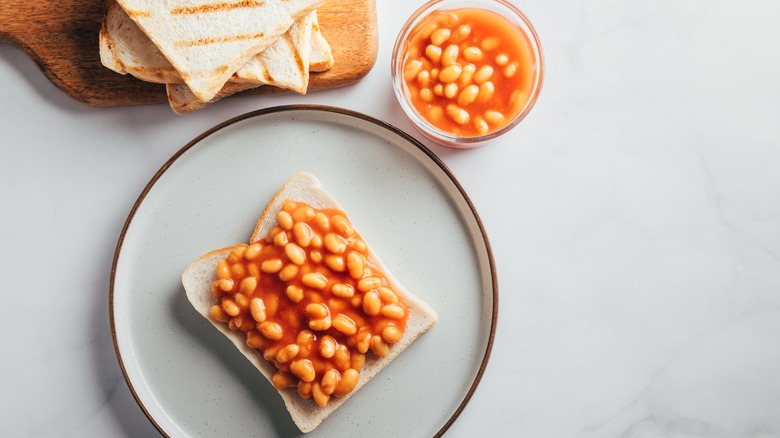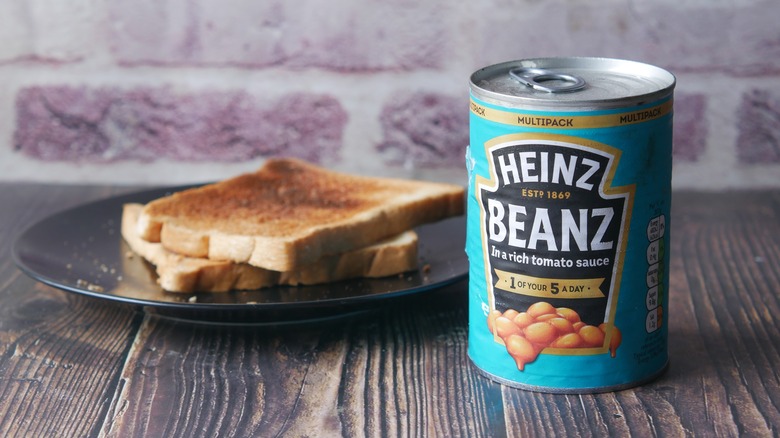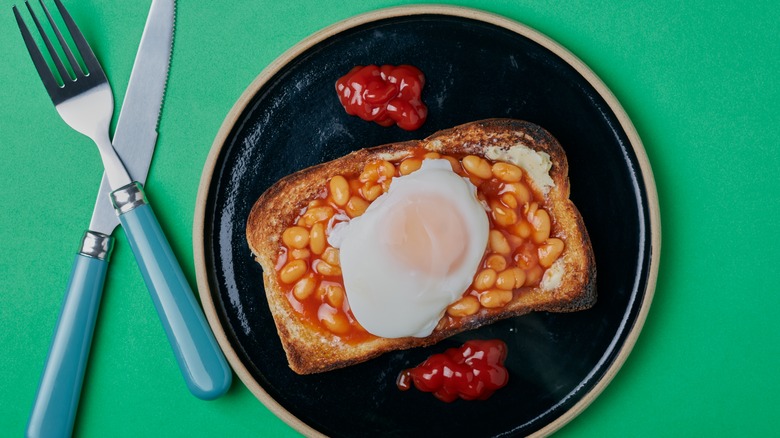The Origin Of Beans On Toast As A UK Breakfast Classic
In 2020, beans on toast briefly went viral as it was "discovered" by Americans who'd long been blissfully and surprisingly unaware of the delicious United Kingdom classic. Although most Americans who responded were generally unimpressed with the idea, it's one of those don't-knock-it-until-you've-tried-it foods. How do we figure? For starters, Patrick Stewart posted a video to X, formerly known as Twitter, calling it "My signature dish since 1948," and we all know that Stewart is an absolute treasure who must be protected at all costs.
Similarly, in an interview with Air Mail, Stephen Fry stated that he would want his last meal to be beans on toast, while his ideal weekday lunch is "Fewer beans on toast," and his perfect weekend lunch is "Beans on toast topped with two poached eggs."
For anyone still doubting the popularity of this dish, it's worth noting that a 2024 YouGov poll determined that it ranked ninth on the list of the UK's most popular foods, just below bangers and mash and above pigs in blankets. (Number One was fish and chips.)
But how did this seemingly simple meal gain such widespread and long-lasting popularity? The history of the dish seems to at least partially go back to the same place that condemned it for sounding less-than-palatable, and that, of course, is America. Let's start in Pittsburgh and see how beans made the jump across the pond to be immortalized in beans and toast.
It's not beans and toast without Heinz beans
Americans are familiar with various regional styles of baked beans, such as Boston and Kansas City versions. Beans and toast uses a very different type; it's a straightforward, tomato-y variety. Purists say that Heinz baked beans are all that should be used for traditional beans and toast, and the Heinz company traces its roots back to Pittsburgh, 1869, and Henry Heinz's first product: horseradish.
When Heinz Baked Beans hit the UK, they were considered a luxury item. Dann Woellert—a food etymologist and the author of books including Cincinnati Goetta: A Delectable History — says a high-end grocery store called Fortnum & Mason was the first to sell canned beans at the end of the 19th century. The beans weren't just a novelty; they ushered in a new era of convenience when an emerging working class sought more ways to make delicious but quick meals.
In 1927, Heinz launched an advertising campaign that really pushed its beans, which involved presenting and popularizing beans on toast. Initially marketed as part of a traditional English breakfast, it was so popular that by 1928, Heinz needed to open a factory in London to keep up with demand. There was no looking back, and beans and toast have remained a massive favorite and an important part of the British diet: During World War II, beans were one of a few foods exempt from wartime rationing.
What's the right way to prepare beans on toast?
For any naysayer who hasn't experienced the pure joy of beans on toast, this is truly a learning opportunity. British cuisine might have a bad reputation, but scores of traditional British foods should be on your must-try list. (They are, after all, the home of dishes like the Beef Wellington, the Sunday roast, and the amazing sticky toffee pudding.) Get this one right, and it might just be your new go-to comfort food.
The beans are key: British-style Heinz baked beans don't have the sugary, molasses-heavy sweetness that many American baked beans do, and they're much more tomato-forward. (The meal is also a favorite of Queen Camilla's, and she agrees that it's Heinz beans all the way.) Brits take their beans very seriously and know that storing the cans upside down and shaking them well before opening means that sauce will be evenly distributed when you pour the beans out.
Warm your beans on the stove — but never boil them, as they'll split. Meanwhile, toast thick slices of white bread, which you'll then butter. (Some recommend only unsalted butter, while others think that guideline is equal parts unnecessary and ridiculous.) Pour the warm beans on the toast, add some grated cheese if you'd like — or a poached egg, as Stephen Fry recommends — and eat immediately. It's as delicious as it is simple, and there's a reason it's been popular for generations.


